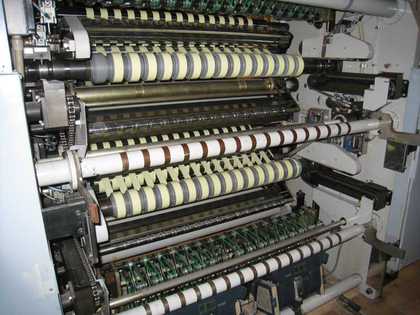
Former ORWO head quarter (build in 1936-8), since 2010 it has been used as town hall

ORWO film cutting machine, view from side where the cut to size film comes out
The small-scale production of batches of fluorescent tubes used in Dan Flavin’s light-based artworks provides an example within contemporary fine art conservation of now obsolete commercially produced components being re-fabricated in small scale production. For the last ten years, Dan Flavin’s studio has organised the production of specially pigmented fluorescent tubes, that are no longer available ‘off the shelf’, for a consortium of museums and collectors. Closer to slide technology, there is also an example of the reintroduction of a once legendry analogue film process provided by the Impossible Project. Here ten former Polaroid employees took over the last production plant of integral instant film in Enschede, in the Netherlands, shortly after Polaroid shut down in 2008. Since then, they have launched at least four different instant films and are supported by enthusiasts around the globe.
Both of these initiatives prompted me to investigate whether it would also be possible to produce small-scale slide duplicating stock independent of Kodak and Fuji. To explore this option, I visited Filmotec ORWO in Germany. ORWO was originally AGFA and was renamed after the latter was re-established in West Germany at the end of the Second World War. ORWO produced most analogue film materials for the communist world under the brand ‘Original Wolfen’. This included the production of slide film until 1990. Today they manufacture black/white motion picture film stock for a specialist market and this stock is considered superior to the quality of equivalent stock produced by Kodak. In talking to ORWO it became clear that producing colour film stock is a far more complex industrial process than the production of b/w film stock, given the multilayered photographic emulsion and the chromogenic dyes involved. The staff at ORWO explained that it would only be cost effective to produce a slide duplicating stock if the stock were produced in very large quantities; their direct reply humorously indicated the difficulty of the task:
If you are able to produce an order for an amount over the size of two football fields (120 m long and 90 m wide) and have 2 million Euros to spare for testing and are able to give us two years’ notice, we could look into this further.1
It became clear that it would be extremely difficult to launch a project to produce the amounts of slide duplication stock needed to keep artists’ slide installations displayable, largely because the industrial infrastructure needed and the complexity of the process cannot be compared with that used to produce fluorescent tubes or Polaroid instant film.
